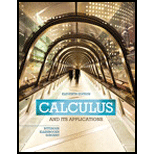
Concept explainers
Verify Property 2 of the definition of a probability density function for each of the functions in Exercises 1-12. Check using the answers to Exercises 1-12.
Want to see the full answer?
Check out a sample textbook solution
Chapter 5 Solutions
Calculus and Its Applications (11th Edition)
Additional Math Textbook Solutions
Precalculus
Precalculus
Single Variable Calculus: Early Transcendentals (2nd Edition) - Standalone book
Calculus, Single Variable: Early Transcendentals (3rd Edition)
Precalculus Enhanced with Graphing Utilities (7th Edition)
- Repeat Example 5 when microphone A receives the sound 4 seconds before microphone B.arrow_forwardIn 1938, a physicist named Frank Benford discovered that the number 1 appears in the first digit of random data more often than the number 2, the number 2 more often than the number 3 and so on. In general, the probability of occurrence of the first digit of a number can be written in the form of a probability function x + 1 P(X = x) = log. X a. Prove it P(X = x) = log ) untuk x = 1,2,3,4...,9 x+1 X x = 1,2,3,4..., 9 is a probability mass function 2 b. Find the cumulative distribution function of X!arrow_forwardPlease answer this one with solution. Let the function be as shown. If the first event is denoted by the interval (1,2) and the 2nd event is denoted by the interval (4,5). (a) Find the probability the probability of P(E1 U E2) (b) P(E1 ⋂ E2)arrow_forward
- question (a) to (d)arrow_forwardExample 2: Consider the following function shown below, Use it to answer the following questions. x3 P(x) = 9' x = 0,1,2 a) Determine whether or not the function shown above is a valid probability function. b) Construct a probability histogram for the function shown above and comment on the shape. domye c) Find P(x > 1)arrow_forwardIn Exercises 1-12, verify Property 2 of the definition of a probability density function over the given interval. 1. f(x) = 2x, [0, 1] 3. f(x) = 3, [0,] 5. f(x) = x?, [1,3] 2. f(x) = x, [1, 3] 4. f(x) = }. [3,8] 6. f(x) = , [0, 4] 7. f(x) = - (1, e]arrow_forward
- part D E needarrow_forwardWould like to ask part d) and part e). Already know a) is 1-exp(-t), b) is exp(-h(x)), c) is exp(-h(x))*h(x), please do not answer these 3 parts again. Thank you!arrow_forwardQ.2 Let X has the following probability density function: fx(x) = a e-ax;x > 0 Find moment generating function and then using it find mean and variance. End of Quizarrow_forward
- Page 8 of 9 12. The continuous random variable X has probability density function (2re , fx(x) = 10. otherwise. Find the probability P(1 < X < 2).arrow_forward3 Let X be the number of siblings of WSU students. The pdf of X is: f(x) = (5-x)/15 for x = 0, 1, 2, 3, 4 What is the probability that a randomly selected student has 3 or more siblings if it is known that they are not an only child X 0.133 X 0.2 / 0.3 O X 0.667 X 0.933arrow_forwardLet o denote the Euler phi-function. If F is defined by F(n) = Σφ(d?) d|n Is F multiplicative? Explain your answer. Larrow_forward
 Trigonometry (MindTap Course List)TrigonometryISBN:9781337278461Author:Ron LarsonPublisher:Cengage Learning
Trigonometry (MindTap Course List)TrigonometryISBN:9781337278461Author:Ron LarsonPublisher:Cengage Learning
